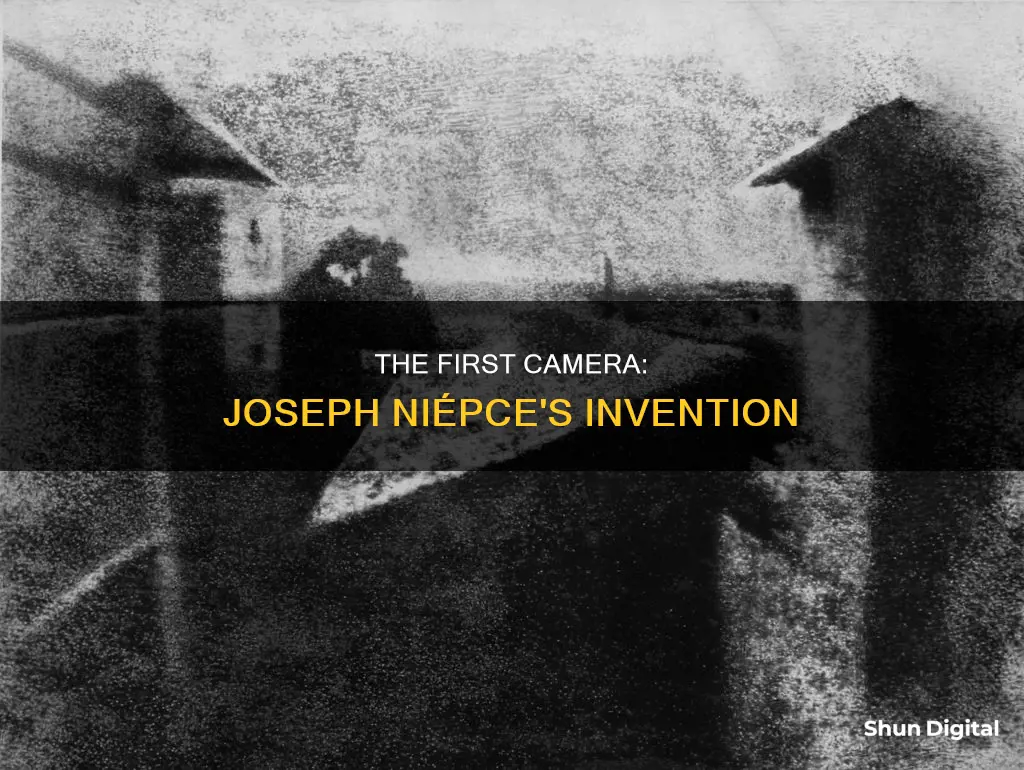
Joseph Nicephore Niepce is credited with creating the first photograph. Born in 1765 in France, Niepce was an amateur scientist, inventor and artist. He was particularly fascinated with the idea of capturing images, and in the early 19th century, he experimented with a process known as heliography, which translates to sun drawing. Niepce discovered that by coating a metal plate with a light-sensitive material and exposing it to light, an image could be produced. In 1826, he coated a pewter plate with bitumen and exposed it to light through a camera obscura for several hours, creating the first photograph.
| Characteristics | Values |
|---|---|
| Inventor | Joseph Nicephore Niepce |
| Birthplace | Chalon-sur-Saône, France |
| Born | 7 March 1765 |
| Education | Oratorian College in Angers |
| Occupation | Staff officer in the French army under Napoleon |
| Previous inventions | Pyreolophore, one of the world's first internal combustion engines |
| Year of first photograph | 1826 |
| Technique used | Heliography |
| Process | Coated a pewter plate with bitumen, a type of natural asphalt, and exposed it to light through a camera obscura for several hours |
| Image captured | View from his window |
What You'll Learn

Joseph Nicephore Niepce's early life
Joseph Nicephore Niepce was born on March 7, 1765, in Chalon-sur-Saône, France. His father was a wealthy lawyer and King's counsellor, and he had one sister and two brothers, including his older brother Claude, who would become his collaborator in research and invention. Niepce studied at the Oratorian college in Angers, where he was baptised and adopted the name Nicéphore in honour of Saint Nicephorus, the ninth-century Patriarch of Constantinople. He excelled in his studies of science and the experimental method and went on to become a professor at the college.
Niepce then served as a staff officer in the French army under Napoleon Bonaparte, spending time in Italy and on the island of Sardinia. However, due to poor health, he was forced to resign and returned to his native town of Chalon-sur-Saône. In 1795, he settled in Nice, where he married Agnes Romero and became the Administrator of the district in post-revolutionary France. Niepce resigned as administrator in 1795, and his resignation was reportedly due to his unpopularity.
In 1801, Niepce returned to his family's estates in Chalon-sur-Saône, where he and his brother Claude devoted their lives to experimentation and invention. They managed the family estate as independently wealthy gentlemen-farmers, raising beets and producing sugar.
The Keystone K7 Camera: A Rare Vintage Find
You may want to see also

Niepce's invention of photography
Joseph Nicéphore Niépce was born in 1765 in Chalon-sur-Saône, France, and came from a wealthy background. He was an amateur scientist, inventor and artist, and served as a staff officer in the French army under Napoleon. After his military career, he became the Administrator of the district of Nice in post-revolutionary France but resigned in 1795 to pursue scientific research with his brother, Claude.
In 1807, the brothers invented the world's first internal combustion engine, which they called the pyreolophore. However, Niépce is best known for his experiments with photography.
In around 1816, Niépce became interested in lithography and began to explore ways of using light-sensitive materials to produce images directly on a printing plate or stone. He was also fascinated by the camera obscura, a drawing aid that was popular among affluent dilettantes in the late 18th and early 19th centuries.
Niépce's first experiments involved positioning sheets of silver salts-coated paper at the back of a camera obscura. In May 1816, he produced the first image of nature: a view from a window. However, this image vanished as the coated paper blackens when exposed to broad daylight.
Seeking to obtain positive images, Niépce turned to compounds that are bleached by light instead of blackened. He experimented with salts, iron oxide, and manganese black oxide, but struggled with the fixing process.
In the mid-1820s, Niépce used a primitive camera to produce the oldest surviving photograph of a real-world scene. He called his process heliography, which means 'sun drawing' in Greek. To create a photograph, he dissolved light-sensitive bitumen in oil of lavender and applied a thin coating over a polished pewter plate. He inserted the plate into a camera obscura and positioned it near a window in his second-story workroom. After several days of exposure to sunlight, the plate yielded an impression of the courtyard, outbuildings, and trees outside.
In 1829, Niépce entered into a partnership with Louis Daguerre, and together they continued to experiment with heliography. Niépce died in 1833, and his work was largely overshadowed by Daguerre's subsequent invention of the daguerreotype in 1839.
Disabling Night Owl Cameras: Display Mode Tips
You may want to see also

The process of heliography
Niepce knew that the acid-resistant Bitumen of Judea, or natural asphalt, used in etching hardened when exposed to light. He coated plates of glass, zinc, copper, pewter, and limestone with the substance, and found that the areas exposed to the most light resisted dissolution in oil of lavender and petroleum. This meant that the uncoated shadow areas could be treated with acid etching and aquatint to print black ink.
In 1822, Niepce made the first light-resistant heliographic copy of an engraving, which he produced without a lens by placing the print directly onto the light-sensitive plate. He then exposed the plate to sunlight for several hours. However, this image is not considered the first photograph as it was not taken with a camera obscura.
In 1826, Niepce began using pewter plates for his heliographs as their reflective surface made the image more clearly visible. To create his heliographs, Niepce dissolved light-sensitive bitumen in oil of lavender and applied a thin coating to a polished pewter plate. He then inserted the plate into a camera obscura and positioned it near a window. After several days of exposure to sunlight, the plate yielded an impression of the view outside.
Niepce wrote about his process in December 1827, acknowledging that it required further improvements but was nevertheless an important step in a new direction. In 1829, he published a detailed account of his procedure in his work "Notice sur l’Héliographie".
Mastering Camera Mode in Elite Dangerous
You may want to see also

Niepce's other inventions
Joseph Nicephore Niepce was a French inventor and one of the earliest pioneers of photography. He developed heliography, a technique he used to create the world's oldest surviving products of a photographic process. In the mid-1820s, he used a primitive camera to produce the oldest surviving photograph of a real-world scene.
Niepce was also an inventor of the Pyréolophore, one of the world's first internal combustion engines, which he conceived, created, and developed with his older brother Claude Niepce. The Pyréolophore was an internal combustion engine fuelled by lycopodium powder. It was sufficiently powerful to move a boat, and trials of it were conducted on a pond at St. Loup de Varenne and on the Saône. The Niepce brothers attempted to render the engine more economical by substituting pulverized coal and then petroleum for the expensive lycopodium powder.
In 1818, Niepce became interested in the ancestor of the bicycle, a Laufmaschine invented by Karl von Drais in 1817. He built himself a model and called it the vélocipède (fast foot) and caused quite a sensation on the local country roads. Niepce improved his machine with an adjustable saddle, and it is now exhibited at the Niepce Museum. In a letter to his brother, Nicéphore contemplated motorizing his machine.
In 1807, the imperial government opened a competition for a hydraulic machine to replace the original Marly machine that delivered water to the Palace of Versailles from the Seine River. The Niepce brothers conceived a new hydrostatic principle for the machine and improved it once more in 1809. They tested it many times, and the result was that with a stream drop of 4 feet 4 inches, it lifted water 11 feet. However, they were ultimately unsuccessful in this endeavour.
GoPro Cameras: Which Models Offer the Longest Battery Life?
You may want to see also

The impact of photography on society
In 1826, Joseph Nicephore Niepce used his heliography process to create the world's first photograph. This was a major milestone, paving the way for the development of photography as we know it today. But what impact has photography had on society?
Art
Photography has given artists a new medium to work with and opened up new avenues for creativity. It has enabled artists to capture and preserve the beauty of the world in ways that were not previously possible. Photography has also influenced the development of new artistic movements, such as realism in the mid-19th century.
Science and Research
The camera's ability to capture and record the world has made it an invaluable tool in scientific research. It has been used to document evidence on field trips, exhibit photographs of distant tribes, and capture images of newly discovered plant and animal species. Photographic technology has also led to innovations in brain scanning and the assessment of the human body.
Journalism
The invention of photography revolutionized the field of journalism by allowing reporters to document and capture images of events as they unfolded, providing readers with visual representations of the news. This paved the way for modern photojournalism and changed how news is reported and consumed.
Historical Record
Photography has played a significant role in our conception of history by providing an objective record of real events. Photographs have been key in confirming historical events, such as the ravages of wars and the horrors of the Holocaust. They serve as proof to support historical facts and help historians and philosophers gain a practical view of life, influencing their findings and research.
Social Connections
Photography has facilitated the emergence of citizen journalists and helped long-lost families reunite. It has also played a role in solving mysteries and building friendships across religious, social, political, and ethnic lines. Social media platforms, with their emphasis on visual content, have further amplified these impacts.
In conclusion, photography has had a profound and far-reaching impact on society. It has shaped how we see the world, how we remember the past, and how we document and preserve important events and cultural practices. Photography is an integral part of our lives, influencing art, science, journalism, and our understanding of history and each other.
Correcting Warping: Camera Raw's Superpower
You may want to see also
Frequently asked questions
Niepce was interested in the new technique of lithography and wanted to use light-sensitive materials to produce images directly on the printing plate or stone. He soon turned his attention to substances that were affected by light, eventually concentrating on Bitumen of Judea, a naturally occurring asphalt.
In 1822, Niepce created what is believed to have been the world's first permanent photographic image, a contact-exposed copy of an engraving of Pope Pius VII. He used his heliography process to create this image.
Niepce's first image was destroyed when he attempted to make prints from it.
The earliest surviving photographic artifacts by Niepce, made in 1825, are copies of a 17th-century engraving of a man with a horse and what may be an etching or engraving of a woman with a spinning wheel.







